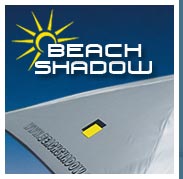Sun Facts Why beach shelters, beach tents, beach shade? We know that too much sun is bad, so it is natural instinct to seek shade as well as a scientific fact. The level of protection offered by sun shelters varies (due to fabric specifications) coupled with the type of shelter (they can be heat traps that do not allow air to flow through so put you off trying to get out of the shade). The World Health Organisation recommends that you seek shade and people are responding to this message by using portable shade devices. What is all this UV stuff about then? The sun gives off a huge amount of energy in various forms such as visible light and what we feel directly, heat (infrared). However there are harmful types of radiation that we can neither see nor feel and this is what aggravates us humans so much, especially if we overdo it. A little more about Ultraviolet Radiation (UVR) Ultraviolet radiation (UVR) is made up of different wavelengths which have been given the names, UVA (long wavelength), UVB (middle wavelength) and no guessing for the last one... UVC (short wave length).The really bad rays are the UVC, luckily a lot of these naughty rays are either absorbed in space or dealt to by the ozone layer (now you know why we need to look after this ozone layer). Some UVB and most of the UVA aimed our way gets to our earth's surface where we hang out. So what is sunburn? Sunburn is the skin's reaction to ultraviolet radiation (UVR). Without any form of protection during periods of high UV radiation, UVR immediately starts to penetrate deep into the layers of the skin. After a certain time, sometimes in as little as 15 minutes depending on skin type and UV radiation intensity, the skin releases chemicals (another neat auto function of the human body) that causes the blood vessels to expand and leak fluids, causing inflammation, pain and redness - otherwise known as SUNBURN. Pain associated with sunburn can last up to 72 hours after exposure to the sun. What else does UVR do to us humans? Exposure to UVR can not only cause sunburn but also lasting skin damage. This may result in premature skin ageing and skin cancer. UVR can also cause eye disorders such as cataracts. The World Health Organisation, friends in high places for guidance! Luckily for us the good people at the World Health Organisation and various agencies' around the planet have come up with a few simple charts to make sense of UVR, how it affects us humans and what precautions we can take to minimise the exposure, so have look below and see if any of it makes sunsense. The Ultraviolet Index : UV Index ranks the UV radiation levels and risks for human health. The UV index is approved and recommended by World Health Organization (WHO).The index predicts UV intensity levels on the scale of 0 to 10+, where 0 indicates a minimal risk of overexposure and 10+ means a very high risks of solar UV intensity variations : |
|


